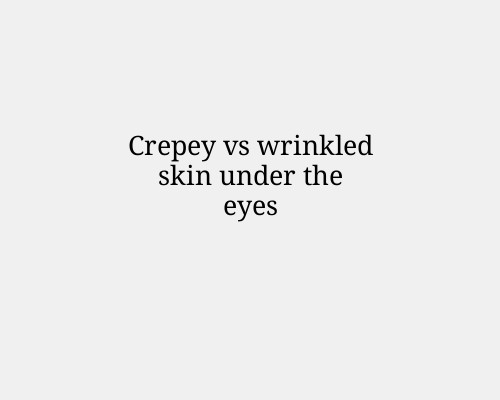
Crepey vs wrinkled skin under the eyes: Understanding the difference and treatment approaches
The skin under your eyes is some of the thinnest and most delicate on the body, which makes it particularly susceptible to signs of aging. Among the most common concerns are crepey skin and wrinkles—terms often used interchangeably, but which refer to distinctly different conditions. Understanding the difference between these two is critical when choosing the most effective treatment options.
What is crepey skin?
Crepey skin refers to a texture change in the skin where it becomes thin, loose, and finely wrinkled—resembling crepe paper. It’s often accompanied by a lack of elasticity and can feel fragile or papery to the touch. Unlike deeper wrinkles, crepey skin tends to affect larger surface areas and may appear more diffuse.
Causes of crepey skin under the eyes:
Loss of collagen and elastin: These are structural proteins that provide firmness and elasticity.
Dehydration: Chronic dryness exacerbates thinness and fine wrinkling.
Sun exposure: Ultraviolet (UV) damage accelerates the breakdown of skin support structures.
Age-related thinning: As we age, the skin naturally loses fat and moisture.
Genetics and lifestyle factors: Poor nutrition, smoking, and lack of sleep can all play a role.
What Are wrinkles?
Wrinkles are folds, creases, or ridges in the skin that can be superficial or deep. Under the eyes, these often present as crow’s feet, fine lines, or under-eye folds caused by repeated muscle movement (like squinting or smiling) and a gradual reduction in skin elasticity.
Causes of wrinkles under the Eyes:
Dynamic facial expressions: Repeated movements create permanent creases over time.
Aging: Natural aging leads to a breakdown in collagen and elastin, causing skin to sag and fold.
UV exposure: Like crepey skin, wrinkles are heavily influenced by sun damage.
Smoking: Reduces blood supply and speeds up the aging process.
Poor skin care: Lack of proper moisturisation and exfoliation can worsen the appearance of wrinkles.
Key differences between crepey and wrinkled skin
Feature Crepey skin Wrinkled skin
Texture Thin, papery, finely crinkled Folds or lines, may be deep Location/Area Diffuse, affects wider area Localized, follows expression lines Elasticity Severely reduced Some elasticity may remain
Cause Aging + moisture/collagen loss Repetitive motion + aging
Appearance Loose, sagging skin Defined lines or creases
Why the distinction matters for treatment
Treating crepey skin as if it were simply wrinkled can result in disappointing outcomes. The key is understanding that crepey skin is a textural problem, while wrinkles are structural and dynamic. Each condition requires a different approach.
Treatment Approaches for Crepey Skin under the eyes
Hydration and moisture retention
Use eye creams with hyaluronic acid, glycerin, and ceramides.
Choose formulations specifically designed for thin, sensitive skin.
Topical Retinoids
Retinol helps stimulate collagen production and improves cell turnover.
Use low-strength versions formulated for the eye area to reduce irritation.
Peptides and growth factors
These encourage skin regeneration and boost elasticity.
Chemical exfoliants
AHAs (like glycolic acid) can improve texture, but use sparingly under the eyes.
Non-invasive treatments
Microneedling with PRP (platelet-rich plasma) helps rebuild collagen.
Radiofrequency therapy promotes skin tightening.
Lifestyle changes
Stay hydrated, avoid smoking, and protect against sun exposure with SPF and sunglasses.
Treatment approaches for wrinkled skin under the eyes
Botulinum Toxin (Botox)
Temporarily relaxes the muscles causing dynamic wrinkles like crow’s feet.
Dermal Fillers
Hyaluronic acid fillers can plump up deep under-eye wrinkles or hollows.
Laser Resurfacing
Fractional CO₂ lasers or erbium lasers improve texture and reduce fine lines.
Retinoids and Antioxidants
Retinol (again) is a gold standard. Antioxidants like vitamin C support collagen.
Facial Exercises and Massage
Stimulate blood flow and may slow wrinkle development (though evidence is limited).
Professional Peels
Light chemical peels can improve the appearance of surface lines.
Preventative Measures for Both Conditions
Use sunscreen daily, even if you're indoors. UV rays penetrate windows.
Wear sunglasses to reduce squinting and protect from UV light.
Get enough sleep, ideally 7–9 hours per night.
Stay hydrated, inside and out.
Avoid harsh rubbing or tugging at the under-eye area.
Incorporate antioxidants in your diet and skincare routine.
When to See a Dermatologist
If over-the-counter treatments aren't helping, or if you’re unsure whether you’re dealing with crepey skin, wrinkles, or both, a board-certified dermatologist can help you evaluate the condition and recommend medical-grade treatments tailored to your needs.
Final Thoughts
Crepey and wrinkled skin under the eyes may seem similar, but they stem from different root causes and require targeted interventions. Crepey skin is more about texture and thinning, while wrinkles are the result of muscle movement and folding. Understanding the difference ensures you don’t waste time or money on treatments that won’t address your specific concern. With a customized approach, you can significantly improve the appearance of your under-eye area and regain a smoother, more youthful look.